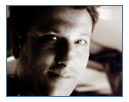|
Rodrigo Dorfman is an award-winning writer, freelance photographer, filmmaker, and multimedia journalist/web designer. His work mixes the immediacy of journalism and performance art with in-depth ethnographic fieldwork and flash technology in order to create multimedia documentary environments. For the past ten years he has been collaborating with his father, Ariel Dorfman, on screenplays, notably for the BBC, HBO and experimental plays for the international stage. POV: In your work, you consider the notion of "borders." What is a border to you?
Rodrigo Dorfman: Ever since I left Chile in 1973 as a child of exile, I've been crossing borders — every conceivable type of cultural, geo/political and religious border. By the time I was living in Amsterdam, at age twelve, I was speaking French in school (I received a French education all through exile), street Dutch with my neighborhood friends and my mother tongue of Spanish at home. As a child, I had the opportunity to reinvent myself a thousand times over, inhabiting the suave designer shoes of a tasty little Frenchman, perhaps taking on the rosy cheeks of a Dutch boy full of milk or masquerading as the naive and exuberant all-American kid with a football and a twang. You name it, I could have been that — and I probably was. POV: What borders did you encounter while working on your pieces?
Dorfman: I encountered two kinds of borders during this project. The first one is experiential and it comes about when I have to film my father (or anyone I'm very close to). The process can get very personal and then sometimes I have to put the camera down during moments when someone else (with more distance) might have kept on filming. And that's the challenge I've set up for myself, isn't it? In order to get the footage, I have to play the role of the objective observer. But the reason I'm allowed to film is precisely because I'm not an objective observer. This situation forces me to be two people at once during the filming. I don't know if I was able to straddle both sides of the border — but just thinking about it — makes me grow taller. POV: What is possible when innovative approaches to narrative and interactivity are combined? How is your piece different from traditional storytelling?
Dorfman: Multimedia, I believe, offers the best possible narrative strategy for someone like me who is interested in breaking down — not just the interpersonal borders that exist between filmmaker and "subject" — but also the narrative constraints of linear time-based story telling. There are many ways to tell a story. And multimedia allows the complexities of a fragmented life to be told in its fullest form. POV: Expand our borders. What's a book, movie, piece of music, website, etc. that challenges or engages with the idea of "borders'" that we should know about but perhaps don't?
Dorfman: My first feature-length online multimedia documentary (it takes more than 50 minutes to absorb — that's my definition) came out of three years of intermittent travels with the Gnawa, a small sub-cultural group of mystical musician healers from Morocco who practice a mixture of Islam and African shamanism. Many of them are the descendent of the African slaves brought into Morocco after the fall of Timbuktu. In the past decade, the Gnawa have undergone a dramatic transition as western world music lovers have discovered their music. And so the Gnawa are moving fast from being part of a poor marginalized sub-culture to becoming "official" representatives of Moroccan culture. They travel; they have cell phones and status. In one of the stories I tell, a Master Musician, after seeing his rotten teeth flash on German TV during a televised concert, decides to get a new set of dentures. He has them glued to his gums because he is afraid of losing them in a hotel like one of his friends recently did! POV: What are you working on next? Where can we see more of your work? Dorfman: I just recently bought the Panasonic AGDVX100B and so now I'm the middle of filming a documentary on American Sufism (the mystical wing of Islam), working on creating a multimedia website for the newly formed Duke Islamic Studies Center and documenting the rise of the "Self-Help Credit Union" in Durham, NC — the most successful Latino credit union in the USA. You can see more of my multimedia work at my website www.melloweb.com |
